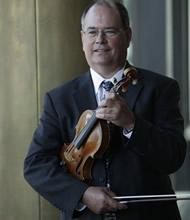 The Ciompi Quartet, all wearing masks, presented a virtual concert Sunday night as part of the Duke Performances Presents series, although the streaming was a bit delayed because of technical issues. The four musicians (Eric Pritchard and Hsiao-mei Ku, violins, Jonathan Bagg, viola, and Caroline Stinson, cello) are professors of music at Duke University and are seasoned pros, having been playing together for years.
The Ciompi Quartet, all wearing masks, presented a virtual concert Sunday night as part of the Duke Performances Presents series, although the streaming was a bit delayed because of technical issues. The four musicians (Eric Pritchard and Hsiao-mei Ku, violins, Jonathan Bagg, viola, and Caroline Stinson, cello) are professors of music at Duke University and are seasoned pros, having been playing together for years.
The performance began with an early work by Anton Webern (1883-1945) who, along with Arnold Schoenberg and Alban Berg, was one of the fiercest proponents of atonality (music without a tonal basis). However, the ten-minute “Langsamer Satz” (slow movement) for string quartet clearly shows the composer’s indebtedness to the late Romantic style of Strauss and Mahler. The work was written for Wilhelmine Mörtl, the woman who would become the composer’s wife, and is a passionate outpowering of his love. This is a lovely gem, full of melodic gestures that are shared throughout the four strings. It is hyper-romantic, offering soaring lines for all, with the first violin playing up into the stratosphere. Tender moments abound as well. All four musicians displayed wonderful sensitivity, great passion, and terrific ensemble.
Next up was the String Quartet No. 3 (“A Tapestry”) written in 2014-15 by Stephen Jaffe (b.1954). The composer, a professor of music composition at Duke, offered some background information about the 25-minute piece. Jaffe explained that working with the Ciompi Quartet has been “like a drink of water for a thirsty man.” The subtitle, “A Tapestry,” comes from the poet Mary Oliver, who stated that the job of a poem is “to bring threads from the spiritual world to the intellectual world.”
The work, “a gathering of musical fragments woven into a whole” (Jaffe) is in six movements. Much of the opening Prelude (fragments) is based on a four-note cell. Some space between utterances adds to the basic easy feel of the movement, although an intense passage does interrupt. A nice duet between the cello and viola is also presented.
Scherzo I: poised and graceful, but impish (“scherzino”) was ebullient in nature, and the musicians etched the sharp rhythms with precision. The brief Joy of rhythm contains both pizzicato playing coupled with short bowed motives and made for a fun listen.
The fourth movement Ribbons (watercolor) begins with a sustained portion that leads to a more moving section. The cello got to take the spotlight a couple of times with a lyric melody, cleanly and expressively played by Stinson.
Scherzo II (“Scherzone” – with Night Blues) is indeed, “wild,” as Jaffe described – frenetic with some crazy sawing contrasting with lots of pizzicato. The energy slowly dissipates and there is a brief pause before the “Night Blues,” which is inspired by a concert that took place three days after 9/11. A more-or-less sustained accompaniment from the viola and 2nd violin supports broken utterances from violin and cello, strongly carved out by Prichard and Stinson. The opening returns. The entire movement is a wonder of ensemble – musicians playing perfectly in synch.
The opening of the Postlude (with light of dove and the rose) is a languid exploration of that four-note rhythm that opened the piece (short-short-short-long). Hmm. Just like Beethoven’s 5th. What follows is more sustained and serious, with a couple of dance-like motives.
One could hardly imagine a more informed and committed performance than this. The musicians undoubtedly worked with the composer in the days leading up to the recording, which provided an informed understanding of the score.
Before the evening concluded with the String Quartet in B-flat, K.172 (1773), by Wolfgang Amadeus Mozart (1756-91), first violinist Prichard thanked the audience for joining the quartet on their “first virtual performance.” He pointed out that this work (as well as the Webern) was written during the composers’ younger years; Mozart was only 17 when he wrote K.172.
The opening Allegro Spiritoso certainly is a confident, joyful movement, with the four musicians given distinctive roles in the music-making. The movement is especially distinguished by the great writing for the 1st and 2nd violins, sometimes in dialogue, sometimes together, in unison or separated by an octave. Prichard and Ku wonderfully performed these passages with clarity and energy.
The Adagio provides a showcase for the melody, given to the 1st violin. Prichard added his own embellishments on a couple of occasions. Close attention to changes in dynamics by the entire ensemble added depth and contrast.
Violist Bagg robustly introduced the main tune in the Menuetto, which was then imitated by the 1st violin. The Trio, in a minor mode, creates a sort of ghostly-whisper character that contrasts to the more cheery compatriot. Upon repeat of the first section, the quartet switched from bowing to pizzicato, adding an interesting change in texture.
The finale Allegro assai bustles with optimism and great writing, with frequent changes in texture. Sometimes the 1st and 2nd violin are pitted against viola and cello; sometimes the action is in the 2nd violin, with a melody in the cello; still other times the viola is the focal point. All are creative treats Mozart gives to the listener.
The Ciompi played the work with assurance; intonation was first-rate, ensemble was terrific throughout, and one had the feeling that the musicians were enjoying playing the sunny piece with their colleagues.











